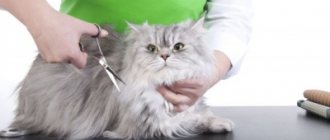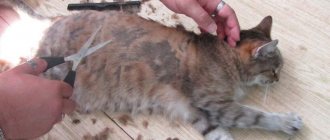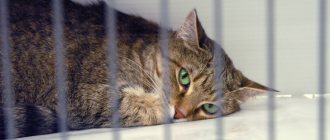How often can you wash your cat?
Cats do not need to be washed daily or weekly; bathing once every 2 months is considered normal.
Watching the cat, it is easy to notice that in her free time from playing and feeding, she likes to “preen” - licking her fur, paws and tail. The animal keeps its fur clean on its own, so it does not need regular bathing. Moreover, too frequent washing can harm the cat, as the pet's subcutaneous glands produce a protective lubricant. The substance is distributed throughout the coat, makes the hair silky, and also serves as a barrier against bacteria. Interesting fact: cats and cats groom themselves differently. Cats spend more time licking their fur and do it more thoroughly than males.
It is important to distinguish between thoroughly washing the cat with shampoo and wiping individual areas of the coat as it gets dirty. If the cat got dirty in the toilet or came home from the street, wipe off the dirt with a soft cloth previously moistened in warm water. This will not harm the pet.
You need to teach a kitten to wash from the age of 4-5 months, so that bathing becomes a habitual ritual, and, as an adult, he would not experience fear of water. In any case, you will have to wash your domestic cat throughout its life, because its fur gets dirty and matted, and you really want the “fur coat” to always be luxurious and well-groomed!
Kitten care
Before purchasing, make sure you can handle raising a new family member. In addition to feeding, playing and grooming, you will have to take care of regular trips to the veterinarian.
What will your baby need?
To move to a new home you will need a carrier. You will also have to use it during trips to the veterinarian or other movements around the city. It is better to choose a house with a plastic bottom and for growth - it is quite possible that an older cat will go in it for sterilization/castration, routine examinations and even exhibitions.
Purchase two bowls in advance - for food and water. It is safer to buy ceramic or metal products, since they will not turn over or move, and they are easier to wash than plastic ones.
In addition to the tray and filler, be sure to take diapers. Be patient while your cat gets used to the litter box, and don't scold him if he makes mistakes.
You will also need to build a personal space. Choose a quiet corner and place a bed or soft house there. Remember that cubs are very active, so stock up on mice, “teasers” and balls. It is better to put wires and other rope-like things away so that the cat does not become interested in them.
To sharpen claws, it is better to choose 2 options: horizontal and vertical claws. You can only find out which of these your pet prefers after the fact.
Maintenance cost per month
Monthly expenses are individual, as it all depends on the preferred brands of food and the prestige of the chosen veterinary clinic.
For the first time, it will take about 4 thousand rubles to buy all the necessary things. This amount includes the carrier, bowls, tray, bed and scratching post. Every month you will have to buy food or natural products and a small package of filler. This will be approximately 1-2.5 thousand rubles per animal.
Sometimes costs may increase. This happens during planned visits to the veterinarian, sterilization and treatment of the disease. The pet must also be treated quarterly for worms. Pets that roam outside will need a flea collar.
When should you bathe a cat?
It is necessary to bathe a cat only if there are good reasons for doing so. Indications for washing your pet:
- More than 2-3 months have passed since the last bath, and the cat’s fur has become dull, darkened, and matted;
- the cat is very dirty, for example, rolled in the mud or covered in paint;
- If parasites are found in the fur, you need to immediately bathe the cat and then treat the “fur coat” with an antiparasitic agent. You should especially carefully examine cats that are often outdoors and can “catch” ticks and fleas;
- washing may be recommended by a veterinarian if a cat develops allergies, lichen, dermatitis and other skin-related diseases;
- if you find a kitten on the street and decide to take it into the house, then you cannot do without water procedures;
- In preparation for the exhibition, you will have to wash the cat with a special shampoo and give your pet a “styling.”
What not to do when bathing an animal
Common mistakes that cat owners make when carrying out hygiene procedures for them:
- You should not open the tap and immerse the cat in water - a strong flow will scare him;
- you should not turn on the shower and try to wash off the foam from the animal with a stream of water;
- a frightened animal should not plug its ears with cotton wool - this will only cause it irritation;
- It is not recommended to bathe a cat with dog products, shampoos for other animals, and especially with dishwashing detergent;
- Shampoo is often poured from a jar directly onto the wool - this is wrong, especially if the skin is dry;
- You shouldn’t try to calm the cat down by feeding him sedatives - they do more harm, and there are side effects.
© shutterstock
Contraindications for swimming
In some cases, you cannot wash your cat:
- during rehabilitation after surgery. Typically, complete recovery takes about a month, but it all depends on the degree of intervention in the body and the pet’s health condition;
- late pregnancy. Washing can be very stressful for a cat and can even cause premature birth;
- within 2 weeks after vaccination. The cat’s immunity is weakened, and it is better to postpone washing;
- if the animal is sick, bathing can worsen its condition. Cancel water procedures and follow the veterinarian’s recommendations.
How to make the washing procedure more comfortable
Not all cats favor water procedures. Most of our affectionate pets, once in a basin of water, struggle furiously, try to break free, slip out of our hands, desperately scream and scratch, and sometimes even bite.
Even those who love water can behave inappropriately. Therefore, an extra pair of hands will never hurt you. It is better if it is a family member whom the cat trusts. If your assistant is not well known to her, this may create additional difficulties.
In addition, before bathing, you need to trim your cat's claws. If your pet wears anti-scratch pads, this makes hygiene procedures less dangerous.
Preparing to wash your cat
Trim your cat's nails to prevent him from scratching you while bathing.
Comb the fur and remove tangles.
Choose a place for bathing - a bathtub, sink or basin. The bathtub is perfect for large cats; you just need to cover the bottom with non-slip bedding. Many owners wash their pets in sinks. The option with a basin is less convenient, since the cat may begin to grab onto its edges; give preference to a container with a volume of about 30 liters or buy a special bath.
Remove all foreign objects from the sides of the bathtub or sink, hide washcloths and other things that the cat can get caught on.
Make sure you have everything you need to bathe your pet on hand:
- shampoo selected specifically for cats (laundry soap and detergents are not suitable for humans - cats have a different skin Ph);
- a hat that covers the cat's ears, or cotton swabs that can be placed in the ears, or you can tie a small bag on your head like a scarf;
- soft washcloth for washing hair;
- a large towel in which to wrap the cat after washing so that it does not freeze and cannot scratch you;
- standard towel for collecting remaining moisture and drying;
- caring assistant (preferably).
Check the temperature in the room where you are going to wash your cat. Pets can easily become hypothermic and get sick, so the air should be no colder than +22 °C.
Pour water into the bathtub, basin or sink in advance. The cat is more afraid not of the bath itself, but of the sound of water pouring from the tap. Before starting water procedures, add warm water to a level of about 10 cm so that the water reaches the cat’s belly. The animal must stand confidently on its paws, but so that its head does not get wet. By the way, you can also pre-fill a watering can with water, with which you can then wash off the foam from your pet if he is afraid of the shower. The water temperature should be 38-40 °C. If you don't have a thermometer, place your hand in water up to your elbow. If you do not feel the water, then it is suitable for a cat.
How to properly wash a cat
Before the water gets cold and the cat suspects something is wrong, grab her and take her to the bathroom. Talk to your purr gently, do not make sudden movements that could frighten your pet. Don't forget to close the door - if the cat escapes, it will be difficult to catch, and wet paw marks will remain all over the apartment (possibly along with foam, if you manage to soap the cat).
Gently place the cat in the bathtub, basin or sink. During the dive, you can hold it by the scruff of the neck to prevent the pet from breaking free and scratching you. Put a bathing cap on him or put cotton swabs in his ears. Run warm water over the fur, avoiding the eyes, nose and ears.
It is likely that the cat will be unhappy and begin to resist. She will have to be persistent - for her own good. Grasp the cat's shoulders directly under your chest in your left hand if you are right-handed. This way, your dominant hand will remain free and can be used to lather the animal. If the cat is waving its hind legs, then you just need to sit it down and hold it so that it cannot jump and kick.
At this stage, the assistant will make your task much easier - he can water the cat from a watering can or shower, supply shampoo, a towel and other necessary items, and you will do all the manipulations with your free hand.
Note: pet stores suggest using a short leash with suction cups to bathe your cat. This accessory makes sense to use only as a last resort, since the pet may be more afraid of the leash than the washing, and in the future it will be difficult to lure the cat into water treatments.
Now apply shampoo to the wet cat's fur with light massaging movements. Consistently soap your back, chest, belly and tail, don’t forget about your paws and chin. Do not use too much shampoo so that you do not have to wash off the foam for a long time.
Using a special washcloth, gently wash the cat's face. If you want to wash your cat's hair, ask an assistant to pinch his ears or put cotton swabs in them. Also make sure that water does not get into your cat's nose.
It's time to thoroughly rinse your cat's fur. Rinse off the foam strictly from top to bottom. It is convenient to wash off the shampoo with a hand shower, just do not lift it very high. Residues of detergent should not remain on the cat's skin, as this may subsequently lead to irritation.
If you rinse your pet's fur using a basin, consider its length. For a short-haired cat, one basin will be enough, while for a long-haired cat, several.
Important: you should not wash your cat after feeding or immerse it in water with its head.
When the shampoo is rinsed, remove the purr from the water, wrap it in a large towel and hug your “cocoon” for a few minutes. The cat should come to its senses and calm down.
Memo to an inexperienced cat owner, part 1, when buying a kitten
Olga Mironova, WCF expert (all breeds). President of ALC "Kotofey" How many disappointments, insults and squabbles such a simple and seemingly pleasant event as the acquisition of a small kitten in the house brings. The series of complainants demanding to be “exposed and punished” does not stop. We won’t touch on buying a kitten secondhand in underground passages, near the metro and in markets. This is absolutely equivalent to rescuing a kitten from the street or from the basement of your house. Otherwise, their fate is unenviable: illness, medicine, early death. Once you buy it and take it into your home, treat it, teach it, nurture it. When a kitten is purchased through a club from a well-known nursery, for some reason they believe that they are insured against illness, grief, and disappointment. If you are afraid of all this, it is best to buy a good genre picture with kittens or a photo album. Sheer pleasure and no worries or problems for you. But even seemingly experienced cat lovers are not free from mutual claims and accusations, although their relationships are adjusted by contractual agreements. Let us analyze the main conclusions for emerging grievances and conflicts. 1. “We bought a kitten as a gift from a famous nursery, but a week later he got sick and died. The veterinarian who was called said: “The kitten was sick while still in the nursery” (“the kitten has a congenital weakened immune system”, “the kitten has a congenital defect” - that is, a congenital disease due to which he died). Kittens for sale Cat nurseries Cat food Atlas of cat breeds
Let's start in order.
A kitten is not a toy. Even if you gave it to a child or friend, then along with it you gave his character and destiny. And there is nothing to complain if the cat and the new owner do not suit each other. Interspecies relationships (and we belong to different species and do not know each other’s language) are not easy. Winning the love and soul of a wayward, independent animal is not easy: you need patience, observation and desire. And if you treat the kitten as a piece of furniture and consider that it “owes” you for its feeding and care, then there will be no friendship. But the cat will not obey and serve. If you want to be a “big brother,” get a dog. A cat, even from a young age, is an independent person, is not sold for food and requires respect. If you really want to give a child or friend a gift, don't buy a kitten without one. Go pick up your future pet together. Let them choose each other. I always took into the house a puppy or kitten who chose me. They climbed onto my knees, sat at my feet, and climbed into my bag or carrier themselves. Once a buyer came to me from distant Salokhard, who phoned in advance and agreed to purchase a British kitten. While we were getting acquainted, talking about cats and agreeing on the price, a small Cornish Rex, about which there was no talk at all, climbed into his arms and nestled. He sat, purred, and they left together. And both are still happy. If you are bringing a kitten “as a gift” in the hope that it will be inconvenient for your friend to refuse and your gift will remain in the house, be prepared for complications. “A week later he fell ill and died.” We have to repeat banal things. We are not alone on the planet. A variety of creatures live next to us - from microscopic to giant. We interfere with some, others interfere with us. We have killed countless animals by driving them out of their habitats, but wildlife is trying to displace us by creating new bacteria and viruses. This is a constant process, the struggle for the survival of each species individually. Everyone knows that a strong, healthy Karapuz, sent to kindergarten, will suffer from a variety of respiratory diseases until he acquires immunity to all strains circulating in this group. If there is a need to transfer the child to another child care institution, everything will be repeated again from the beginning. It's the same with a kitten. Each cozy home not only has its own special microclimate, but also its own microflora. Some of its representatives are generally harmless, others have been tamed by people and animals living together. Immunity has developed to them, and they have temporarily become safe. But as soon as the organism living on their territory becomes ill, they manifest themselves as illness or allergies. A newborn kitten, protected by maternal immunity in the form of antibodies received directly into the blood through the placenta or through the intestinal wall from colostrum, does not react to infectious microorganisms and viruses for the first three weeks. His body is not only growing. He works actively, building defenses against many enemies. This protection will be improved throughout life, but in childhood it remains weak for a long time, easily giving in to the onslaught of viral diseases that are especially active and fatal for the kitten: feline panleukopenia, calcevirosis, chlamydia
and many others.
Vaccines have been created against the most dangerous ones, which can quickly lead to death, but their effective use is only possible when the body is so strong that it can independently develop immunity under their influence. This age begins around 6 weeks. Early vaccinations are not effective and require revaccination every 2 weeks until the age of 9-10 weeks. This is a very dangerous period in a kitten’s life.
That is why good nurseries never sell kittens before 8 weeks, when the first vaccination can already be done. I prefer domestic vaccines, especially those that protect against chlamydia. True, they must be repeated at least once every six months, especially for breeding animals, which are always at risk of getting an infection from a sexual partner. Domestic vaccines are produced based on the strains circulating in our country. While in every other place the same virus or microbe lives and acts evil, but slightly different in its properties from the local ones, because they all mutate quite quickly. And for us people, influenza A vaccines do not protect against other strains. And everything would be fine if among the apparently healthy cats of the cattery there could not be those who recovered but became carriers of these viruses. Even the mother of the kittens can be such a carrier. It is almost impossible to know this in advance. If such a cat is the only one in the nursery, then carriage of the infection can be assumed if, at the age of 4-5 weeks, the kittens develop conjunctivitis - purulent discharge from the eyes and runny nose, or clouding of the cornea appears. The suckling immunity no longer works; its own immunity is weak and cannot protect babies completely. If they recover, it means they have managed to develop their own immunity. If they didn’t have enough strength, but they still managed to get out, they could become carriers for some time, or even forever. Outwardly healthy, not sick themselves, they can infect animals in the new home where they are taken, or transmit the infection during mating to a sexual partner if he is not vaccinated or weakened. The owner of such a kitten, who was ill before being sold, may not even assume that his pet, excellent in all respects, is dangerous to other cats. This is the most common cause of conflict among breeders. There is a known owner of a breeding cat who simply stopped treating and vaccinating her cat and the sire. But she didn’t stop providing it to cats for money or for a kitten. "What for? - she says. “A new cat will come and infect him again.” So not only carriers of infections are dangerous, but also their unscrupulous owners. The owners of the best nurseries sell vaccinated kittens and warn buyers: at 4 weeks the eyes festered, everything went away, but be careful. During the dangerous period of life from 4 to 8 weeks, some breeders carry out preventive treatment with immunostimulants and immune serums. This does not exclude the need to vaccinate at regular intervals. Excessive, repeated use of immunostimulants can lead to a breakdown of defenses, therefore they should be used under the supervision of a veterinary specialist. Look at the label on the vaccine vial. It lists 2-4 diseases, the most dangerous ones, that cause the production of antibodies. But there are much more diseases, and no one can guarantee you that a kitten fully vaccinated against them will not catch some other viral infection that will lead to its death.
Purchasing a kitten, which brings you at least the first moment of pleasure from the purchase, from watching the kittens play under their mother,
turns into severe stress for the kitten.
He is immediately deprived of his usual habitat: his home, his basket, his mother’s warm belly, his mother’s poop, which kittens sometimes suck on until they are 3-4 months old, or even later;
familiar food and familiar microflora, not to mention the transport neurosis that may remain with him for the rest of his life. I know a British cat who died from traffic neurosis. Of course, this can also lead to a breakdown of the immune system. At the same time, their own infections, secretly existing in the body, can break through and cause disease, if they were characteristic of this nursery. Most often, signs of illness will appear within a few hours, and the breeder must accept the baby back without complaint, isolate it from the rest and cure it. Whether you take it again or not is up to you. I would treat it myself, informing the breeder about it. But he can also get sick from an infection that exists hidden in your home. Herpes, chlamydia, hepatitis
and many other diseases are dangerous not only for people, but also for their cats. Although cases of infection of humans with these diseases from cats have not been described. Each disease has its own incubation period: from several hours to 2 - 3 weeks. Therefore, a disease that appears after a week is most likely acquired in your home, especially if other animals or birds live in it. Therefore, the veterinarian’s conclusion on purchasing a sick kitten, which is beneficial for you, under certain conditions, can be very reasonably challenged by the breeder. Do not rush to blame the seller for everything; contact the specialists of the club in which the breeder belongs, or independent expert felinologists. But no matter how many conclusions there are, the kitten will still have to be treated, and God forbid he gets better. Congenital diseases and malformations in cats occur quite often, and, as a rule, such kittens are discarded while still under the cat. By 8 weeks, functionally healthy kittens remain for sale. But there are such congenital conditions that literally cannot be called a disease, but their owner is not suitable for breeding and participation in exhibitions. These are various deformations of the tail, malocclusion, extra fingers or, conversely, their absence, the absence of one or more testicles. The most annoying thing is that some of these defects appear at 6-8 months, and sometimes even after a year: misalignment of the head and bite, hooks on the tail. In some cat breeds, the testicles may descend and retract from the scrotum up to 56 months. I myself once brought a magnificent 3-month foreign currency from Germany in 1990. Both the breeder and I examined the kitten very carefully. It was at a seminar in ShSR, and very sophisticated specialists saw this kitten. Everything was in place. At six months, one testicle pulled up from the scrotum, the canal went into spasm, and it could not descend. It wasn’t noticeable right away, but by one year it was under the skin of the abdomen, right at the entrance to the scrotum, but it never went down. I had to return it to its place promptly. Later we became convinced that he passed on this property of the testicle to migrate after a seemingly normal position to his descendants. When buying a kitten, don’t scream with delight: “Oh. how cute! Oh, how cute!” - we were all good in childhood. Carefully inspect him from the tip of his nose to the tip of his tail. If you’re not sure that you’ll see everything you need, ask a consultant from the club to come with you if you don’t have one among your friends. But in this case there is no guarantee that your pet will become a world champion or an excellent producer. The risk of a mongrel great-grandmother emerging from outside the pedigree always remains, justifying the saying “Neither as mother, nor as father, but as a passer-by.” Most kittens by the time of sale are already good at using the toilet and accustomed to feeding themselves. But there are idiots who lose all their skills in someone else’s house for a while. You need to be especially careful and patient with them, because punishing them will only aggravate the stress and ruin the relationship forever. A good purchase and sale agreement that protects the rights of both the buyer and the seller can reduce the risk of acquiring a “pig in a poke.” Read all the points carefully and ask about anything that seems unclear or incorrect. Don't be embarrassed by your lack of specialized knowledge. After all, this does not mean that the seller should take advantage of your illiteracy in cats (maybe you are a super-specialist in another matter), inexperience or shyness. Some breeders offer downright enslaving conditions for purchasing a kitten: the pedigree is issued only to club members, you can mate only with whomever they tell you, and you can only go to “your” shows. If you have paid the breeder in full, all other demands are “from the evil one”, violate your rights as a consumer and fall under consumer protection actions. The kitten's certificate of origin is valid only until you want to buy a pedigree. Its cost is from 150 to 500 rubles, and the breeder gives the buyer the right to buy it back under legal circumstances. Oh, our poverty! In Europe, you buy a kitten with a pedigree, a veterinary passport and a certificate (agreement) for the sale of a healthy animal. A purchase and sale agreement will protect your interests in many courts. It also allows you to go to court if a controversial situation arises. Without it, you are powerless and will never prove anything, because there will always be a convincing response to your accusations.
O. Mironova
Read Memo to an inexperienced cat owner, part 2, vaccinations, skin and ear care
Cats
Kitten care
Memo to an inexperienced cat owner, part 1, when buying a kitten
Drying wool after bathing
Take the freshly washed cat into the room and dry it with a towel. For short-haired cats, one towel will be enough, and for long-haired cats, do not skimp on 2-3 pieces. You can place your pet on a newspaper or hoe so that the dripping moisture is absorbed faster.
For your information: a cat has a so-called air cushion between its skin and the top layer of fur. This layer of air is heated by the animal's body heat and protects the cat from freezing. During bathing, the fur gets wet and temporarily loses its thermoregulatory properties, which is why it is so important to warm the cat with towels after washing and protect it from drafts.
If the cat is not afraid of a hair dryer, then about 10 minutes after bathing you can lightly dry his fur. The air flow should be warm, but not hot. If the cat is afraid of electrical appliances, it is better to wait until the “coat” dries naturally.
Use a special comb to comb the fur.
After washing, your domestic cat needs to stay warm for at least an hour.
How to dry an animal
It is necessary to ensure that the air from the hair dryer is not too hot
To do this, it is better to take several old cotton sheets, although it is better to take your pet out of the bathroom in a terry towel, holding it tightly to you. By blotting the cat one by one with the sheets, you can easily and quickly collect excess moisture from it. You can complete the procedure with a hairdryer if the animal does not object.
For sensitive tailed individuals, a soft bath towel is offered as an alternative. The cat should be wrapped like a baby and lulled to sleep for a short time in your arms or in a warm corner of the sofa. After a nap in warmth and comfort, he will emerge from the towel semi-dry and relatively happy, but it may take two days for him to dry completely.
How to wash a cat that is afraid of water
What to do if your cat is afraid of water? Do you really have to give up bathing completely? This problem can be solved - be patient and smart.
Firstly, do not neglect trimming their nails before washing, because during bathing, especially impressionable cats become very belligerent.
Then play with your cat thoroughly to get him relaxed and tired. You cannot feed your pet.
Having lulled the mustache-striped vigilance, start washing. You need to lower your cat into the water gradually, distracting him with toys. Water should be poured in advance so that the cat does not wait extra time and is not afraid of the unusual sound.
No matter how the cat behaves while washing, there is no need to yell at it or physically punish it - this will only bring additional stress to the animal. To limit movement, you can use a special bathing net, where the cat is placed, like in a bag, and does not go anywhere. Maybe it will remind him of his favorite box?
After finishing washing, treat your cat with a treat - this way she will know that there is a reward waiting for her for bathing!
If your pet still cannot overcome its panic fear of water, you can wash it with dry shampoo. This is a great alternative to traditional shampooing because a good dry shampoo cleans almost as well as a liquid shampoo. Apply the powder to the cat's fur, wait a minute and brush the powder and dirt out.
How to wash your cat's eyes and ears
So, even the most capricious cat was washed, but during bathing we went around the eyes and ears, and they should also be clean.
The cat's eyes are wiped with a cotton swab dipped in clean boiled water or a weak solution of tea or chamomile. Movements should be light, no need to press or rub your eyes.
It's time for ears. There is no need to clean them unless they become dirty. However, after washing the cat, water could get into the ears. You need to wipe the outer part of the ear with a cotton swab, on which it is better to twist an additional layer of cotton wool. Use a clean stick or dip it in a drop of Vaseline oil. Water and other liquids cannot be used. As a rule, cats love to clean their ears and are happy to present them to their owner. Healthy cat ears should be pink, clean, and free of unpleasant odor.
Features of washing cats of different breeds
Some purebred cats have coat characteristics that affect their care. In general, we can say that long-haired cats need to be washed more often than short-haired cats.
A common myth concerns Sphynx cats - supposedly because of their oily skin they need to be washed once a week. In fact, it is better to wipe the Sphynx with wet wipes or a soft cloth, and bathe it only if it is very dirty.
The Burmese cat has a very impressive, shiny, short coat, the beauty of which must be maintained. Instead of washing fine fur, which can make your cat look like a hedgehog, wipe it daily with a piece of suede or a damp cloth. This will help give the “fur coat” a glossy shine. Once a week, the cat should be combed with a mitten or brush. You can use a special cat antistatic agent. Your chocolate will definitely love this massage!
British cats and Maine Coons have sensitive skin, so it is extremely important for them to select specialized shampoos based on their coat type. From low-quality cosmetics, cats can begin to constantly itch and develop dandruff.
How to determine the gender and breed of your pet
The gender of the future pet plays a big role. It affects care habits, behavior and character. Girls have the following characteristics:
- more flexible and good-natured character;
- smaller sizes and less impressive appearance;
- increased cleanliness;
- the presence of estrus, obliging you to put up with mating songs or carry out sterilization.
Cats are more vulnerable to cancer, so the only salvation is timely sterilization. This operation is more complicated than castration of a cat, so its price will be higher. In turn, males differ:
- impressive shapes and attractive appearance (especially purebred individuals);
- instinct of marking territory during the period of sexual hunting;
- love of freedom, arrogance and laziness;
- stronger smell of stool;
- predisposition to urolithiasis.
All of the above features are individual. Cats are also often playful, clean and loving, but a cat can show a difficult character. And if a kitten and a young individual tend to show isolation, then more mature animals, regardless of gender, become increasingly attached to people.
A more obvious pattern can be seen among breeds. Some are phlegmatic, while others resemble a perpetual motion machine. All this will also have to be taken into account. First, describe your family:
- Hard-working. For workaholics, self-sufficient breeds that can entertain themselves on their own are suitable: Russian Blues, Bombays, American Shorthairs. They easily tolerate loneliness without becoming depressed.
- Active. For energetic owners with enough free time, Angoras, Siberians and Maine Coons are suitable - those cats that they love to walk.
- There are children or elderly people. Britons and Ragdolls get along well with small children. Their angelic patience is amazing. Pensioners should recommend calm Persians or talkative Siamese.
If you are allergic to wool, choose a hypoallergenic breed. These include the Sphynx, Cornish and Devon Rex. Due to the lack of fur, sphinxes and rexes love to bask on their master's lap and caress people.
There are exceptions - when the dander of a hairless cat (and they do have it) causes allergies more strongly than fur. Then it’s worth taking a closer look at other breeds - oddly enough, long-haired Siberian cats are included in the group with the lowest level of allergen.
Bathing a cat before a show
Before participating in the exhibition, any domestic cat will have to be washed. Such bathing will have some features:
- You need to wash the cat twice before the exhibition; during the second wash, use a tinted shampoo (or balm) selected depending on the color;
- the foam is also washed off 2 times, first with water, then with a rinse aid or a weak solution of vinegar;
- while drying with a hairdryer, the wool is smoothed with a massage comb with antistatic teeth, starting from the back and ending with the collar;
- Now you can apply powder to the still slightly damp “fur coat”, which will absorb the remaining moisture and make the coat smooth;
- After a couple of hours, finish treating your cat's fur by applying a protein conditioner.
Life hack: how to choose a tinted shampoo for cats of different colors
White pets are washed 2 or even 3 times with shampoo intended for white cats. When reapplying, leave the shampoo on for 2 minutes for a deeper effect, and then be sure to rinse well. White shampoo is also suitable for chinchilla and silver marbled cats, but there is no need to leave the detergent on the coat. If a cream, blue or lilac cat seems a bit dark to you, use the same shampoo to create a lighter, brighter shade.
Cats with rare red, tortoiseshell and merle colors should be washed with red or bronze shampoo. If your cat has a chocolate-colored coat, add a few drops of black to the bronze shampoo. Black shampoo is suitable for fluffy beauties of black colors.
Follow the instructions, and your cat will outshine all its relatives at the show!











